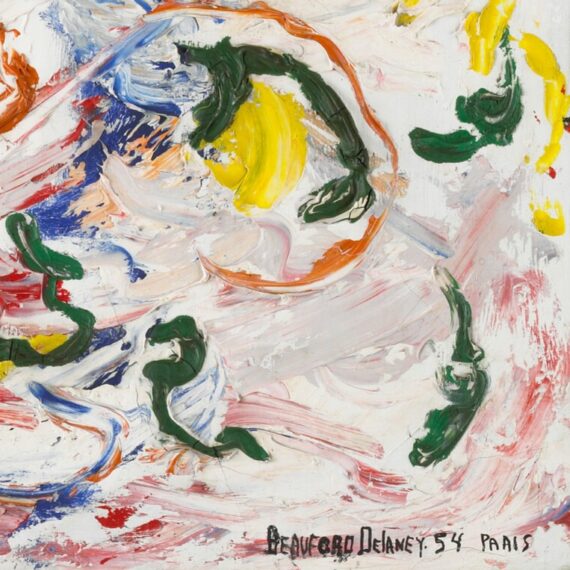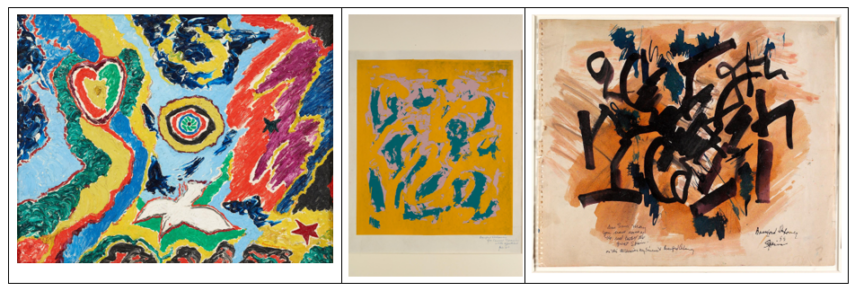
Beauford Delaney’s Untitled
Lesson Objective
Students will look at a selection of artwork from Beauford Delaney and discuss the elements they see. After learning more about the artist and his influences, students will create a work of art that’s inspired by their favorite environment (what they see, hear, and feel) or a personal inspiration, to dictate the look and feel of their own abstract painting.
If you wish to replace or add creative writing, compare and contrast activities, and/or historical research to your lesson, explore the Optional Learning Extensions section.
Introduction
Take a moment to look at the Beauford Delaney painting above. What do you see?
Let’s explore the colors and lines: Swirling green lines, patches of bright yellow, red and blue paint dashed onto the canvas, and thick, white splotches that mix with all the colors. This is an example of abstract art.
Abstract art is a form of art with few to no recognizable subjects. It doesn’t represent exact images of our everyday lives or objects. It uses colors, lines, shapes, and textures to show feelings, ideas, places, and things.
This painting marks a big change in Delaney’s career. A few months before he created it, he had moved from New York City to Paris. He was living in a new place, and his art took a new direction. He developed a lyrically expressive style that drew upon his love of musical rhythms and his improvisational use of color. How does this new information influence how you see this artwork? What type of music inspires you?
Warm-Up Questions
- • Take time to look at the artwork again. What do you see? How does this artwork make you feel?
- • Take a moment to look where you are. What colors do you see around you? What sounds do you hear? How do you feel in this environment?
- • What inspires you? How does that inspiration make you feel? What colors, shapes, lines, textures come to mind when you think about this inspiration?
Background
New York Inspiration

Portrait of Beauford Delaney, 1966, photographic print, gelatin silver. Library of Congress, Prints & Photographs Division, Carl Van Vechten Collection, [reproduction number, e.g., LC-USZ62-54231]. Gift; Carl Van Vechten Estate; 1966.
Delaney lived in a part of New York City called Greenwich Village. In that vibrant and artistic area, the lively streets and diverse people inspired him. He painted street scenes, parks, jazz clubs, and even his own art studio in the Village. But his paintings were not snapshots of real life. Instead, they expressed how it felt to be in the city. The vivid colors, energetic lines, and quick brushstrokes show that being in Greenwich Village was very exciting.
Paris Gave Delaney a New Sense of Freedom
Delaney left New York for Paris in August 1953. Traveling to Paris had been his longtime goal. Like many artists, he thought of Paris as the capital of the art world. In search of new adventure, Delaney wanted to immerse himself in art and experience the social and intellectual life of the city’s cafés. He felt that in Paris he would have a greater sense of freedom.
As a gay African American man, he faced a lot of discrimination in the United States. Paris was a more tolerant place where he believed he’d be treated with kindness and respect.
His new sense of freedom may be one reason Delaney tried a new way of painting. He made fewer portraits and city scenes, and filled his canvases with bright colors, unusual shapes, and bold lines. His work became more and more abstract, with no recognizable objects or figures. And he experimented with different ways of putting paint on the canvas. For Untitled, Delaney used not just a brush, but also palette knives, his fingers, and colors squeezed straight out of the paint tubes.

When you take a closer look, you can see how thick the paint is on the canvas. The green paint was actually squeezed straight from the tube.
An Artist Must Use His Resources Creatively
Delaney had never been rich. He grew up in Knoxville, Tennessee, the son of a Methodist preacher and a former enslaved person. As an artist living in New York, he faced hard times. To pay for his trip to Paris, he rented out his New York art studio, and friends held a fundraiser to help with his expenses. By the winter of 1954, however, most of Delaney’s funds were gone. But friends in the United States sent him gifts for Christmas and his birthday, so he could stay in Paris. Despite shaky finances, he was determined to make his time there a success.
The winter of 1953–54 was hard for Delaney. Temperatures in Paris hit a record low, and his studio was unheated. He had brought along only a thin old coat and couldn’t afford a new one. With so little money, he couldn’t even buy canvas to paint on. Luckily, sometime around January, he received a gift of a warmer coat, a gift that inspired him in a surprising way. He cut up his old coat. It became a canvas on which he created several paintings, including Untitled.
The back of the painting reveals the raincoat. In the upper right corner, you can see an outline of a pocket. If you look closely, you can see the stitching on the raincoat.
More Beauford Delaney Works in Mia’s Collection

Left: Beauford Delaney, American, 1901–1979. Untitled, 1947, oil on masonite. Gift of Dolly J. Fiterman, 2017.138.7. © Estate of Beauford Delaney / Derek L. Spratley, Esq., Court Appointed Administrator; Center: Beauford Delaney, American, 1901–1979. Ciel (Sky), 1960. Color screenprint. Gift of the Harriet Hanley Estate. 2002.114.2. © Estate of Beauford Delaney / Derek L. Spratley, Esq., Court Appointed Administrator; Right: Beauford Delaney, American, 1901–1979. Abstract Composition, 1955, gouache and watercolor on cream paper. Gift of the Harriet Hanley Estate. 2002.114.1. © Estate of Beauford Delaney / Derek L. Spratley, Esq., Court Appointed Administrator.
Art Activity
Materials
- • Paper or canvas
- • Paint (or more accessible art supplies like markers, crayons, or watercolor)
Guided Practice
For clarity, make sure you go through the Introduction and Warm-Up Questions above before moving forward with the guided practice and activity.
Look closely at the artwork again. What do you notice? How would you describe the colors? How would you describe the movement of the paint? How does this make you feel? Why?
Instructions
- 1. Beauford Delaney was inspired by his own surroundings and the people in them. Think about your surroundings, wherever that might be. What do you see in those surroundings? Who is there? How does it feel? Calm, busy, loud, tranquil, etc.
- 2. Referring to the discussion question previously, think about what or who inspires you. How does your inspiration make you feel?
- 3.Use your surroundings (favorite place or current location) or inspiration, and consider the colors, movements, shapes, and texture you want to show in your abstract art. How might these different elements impact the mood and feel you want to create? Like Delaney, music might play an important role in your creative process.
Reflection
After completing your artwork, write a short label. Give your artwork a title and include your name and a brief description about what inspired your work. Share it with your teacher and classmates.
Optional Learning Extensions
Compare and Contrast
Delaney was inspired by the artwork of Claude Monet. Take a closer look at Monet’s The Japanese Bridge. How is the painting similar to Delaney’s Untitled? Different? Write a short essay to compare and contrast the artworks.
Visual Elements Poem
Look closely at Untitled and write a phrase or sentence for each of the following formal elements: color, line, shape, texture. Then combine the four phrases to create a poem.
Example:
Green
Curling and swirling lines
Blotches of yellow
Thick like frosting.
Musicians and Artists in Paris
Like Delaney, many African Americans moved from the United States to Paris. African American jazz musicians, including Josephine Baker, Arthur Briggs, Benny Carter, and Dexter Gordon, all moved to Paris beginning in the 1920s. Use the library or the internet to learn about these musicians and listen to their music. Why did they move to Paris? Select one musician and write an essay about his or her life and inspirations.
Minnesota State Standards
Social Studies
3.4.18.1 Identify various ways that different cultures have expressed concepts of time and space.
6.5.24.3 Identify how the arts have been a part of strategies, activities, and/or engagement for social and political change.
Visual Arts
5.0.4.7.1 – 5.9.4.7.1 Respond: Analyze and construct interpretations of artistic work.
5.0.5.9.1-5.5.5.9.1 Connect: Integrate knowledge and personal experiences while responding to, creating, and presenting artistic work.
